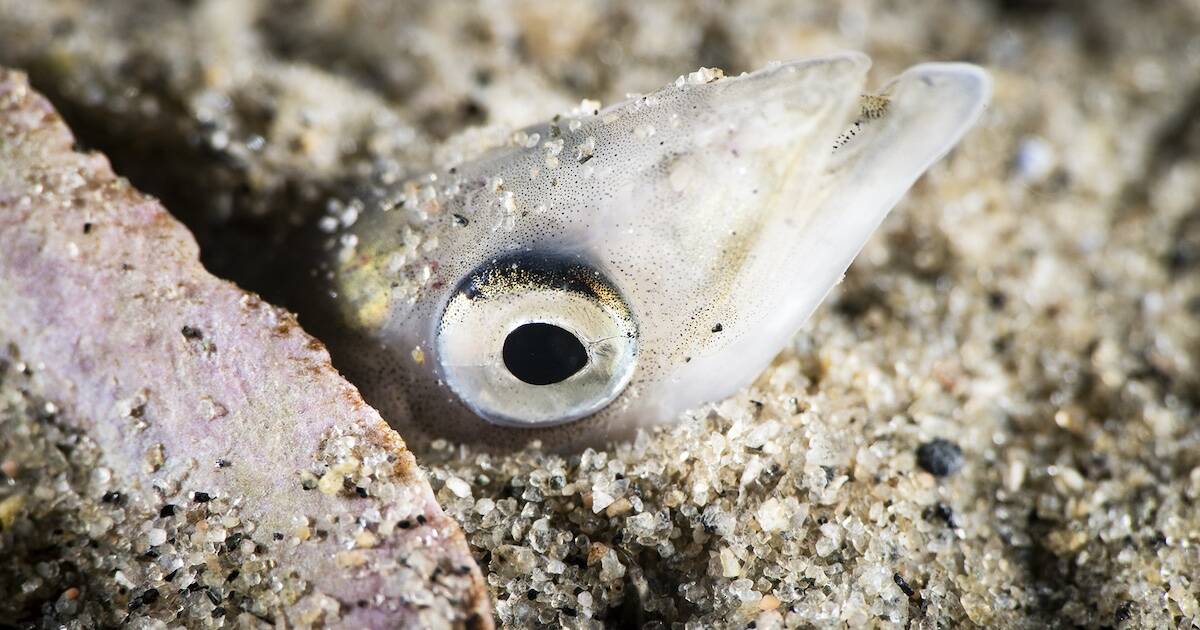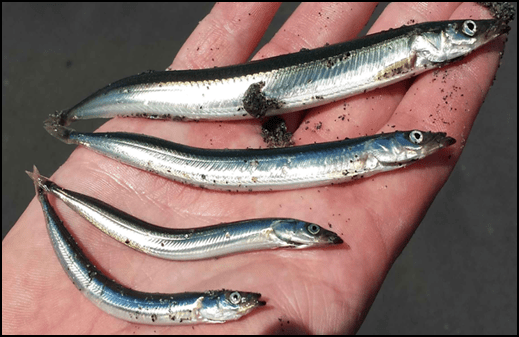
Pacific Sand Lance (Ammodytes hexapterus)
- Phylum: Chordata
- Class: Actinopterygii
- Family: Ammodytidae
What Do Pacific Sand Lance Look Like?
Sometimes called “sand eels,” they have pointed snouts and long, slender, metallic bodies that are marked with diagonal creases which cause them to shimmer iridescent blue, grey, or green on top, and silver underneath, becoming red when spawning. Their tails are deeply forked, and as with everything else about them, their dorsal and anal fins are very narrow and elongated. They don’t have teeth, pelvic fins, or swim bladders. But, curiously, they do have chameleon-like eyes which can move independently of one another. Warmer water temperatures and food scarcity can adversely impact their growth rates and adult size, but even in the best conditions, their maximum length appears to be less than 11”/30 cm.

Pacific sand lance – French Beach, Vancouver Island, British Columbia, Canada
Where Do Pacific Sand Lance Live?
Pacific sand lance are believed to be widespread and abundant throughout coastal waters, from the Bering Sea to Southern California, and the Arctic Ocean to the Sea of Japan, although their distribution has not yet been fully mapped, and their population trends are still unknown. One reason for this is that, true to their genus and family name, Ammodytes, or “sand burrower,” they routinely dig themselves several cm into sand or gravel when they are not feeding, and thus escape inventory surveys. However, it is known that these tough little fish can tolerate an enormous range of temperatures and salinities, which is a good thing, considering how short and brutal their lives are, and how many species depend on them as survival food.
How Do Pacific Sand Lance Grow And Reproduce?
In fact, as they spawn in the intertidal zone (and occasionally the subtidal) along so many of our western beaches, they often serve as a juvenile salmon’s first meal upon completing its journey to the sea.
Sand lance spawn in autumn or winter, as early as August in Alaska, and as late as February in the Puget Sound. Spawning has been documented in the same locations for decades, and it is thought that they return to spawn where they were spawned. Most of those that have been collected for study were one or two years old at the time of reproduction, but some were up to six years old.
Depending on her length, a female will deposit between 1,400 and 16,000 slightly sticky eggs into the sand or gravel a bit below the water line at high tide. The embryos develop over approximately the next two months, frequently enduring periods of sub-freezing temperatures and low-tide exposure. But warm water can cause them to hatch too soon and miss their critical spring feeding time.
They like their sand and gravel to be well-washed, not muddy, and sheltered from pounding wave disturbance, but with enough of a current to keep oxygen levels high. They also seem to prefer good lighting, as they are most abundant in open areas at depths shallower than 50 m—but they sometimes turn up as deep as 275 m.
What Do Pacific Sand Lance Eat?
The short answer is that both adult and larval sand lance primarily eat copepods, small to planktonic crustaceans floating around in the water column or creeping about the shallow seafloor. But the larvae also eat a lot of phytoplankton—minuscule floating photosynthetic plants, and the adults also eat herring larvae and eggs and various small invertebrates that cohabit the intertidal gravel with them.

Pacific Sand Lance Credit: Theresa Liedtke, USGS – Western Fisheries Research Center. Public domain.
What Eats Pacific Sand Lance ?
Besides living near the BC coast, what do salmon, halibut, and rockfish have in common with marine mammals including humpback whales, Steller sea lions, harbor porpoises, and fur seals, and with diving birds such as rhinoceros auklets, marbled murrelets, and red-legged kittiwakes? They all eat a lot of sand lance!
Although these small forage fish hold a place at the very centre of the marine food web, relatively little is known about them. And until recently, they had been studied barely at all—except perhaps by avid fishermen who hoped to imitate them with sufficient accuracy to seduce a salmon. Now that many of their predators’ populations have become threatened, more and more people are starting to pay attention to these seemingly insignificant little fish.

Pacific sand lance (Ammodytes hexapterus) burrowing into the sand Credit: Mandy Lindeberg, NOAA/NMFS/AKFSC Public Domain
What Moves Them And How Do They Survive?
Sand lance are a schooling fish, and have been known to feed just offshore or around wharves with other schooling fish, including herring and pink salmon. In the daytime they often form “bait balls” to protect individual fish from predators and increase chances for future generations when spawning.

Pacific sand lance school
At night, and in the cold depths of winter, they burrow into their sandy homes—and may even go dormant for months to conserve energy—until they are ready to come out and eat again.
Because sand lance are so dependent upon sandy intertidal substrates, they are quite susceptible to beach pollution, especially of the oily variety. Indirect evidence from studies of their predators shows that the Exxon Valdez oil spill of 1989 significantly diminished their populations for a time. So if we want to continue hunting the fish that eat them, we had better look after their habitat.
What Else Are They Used For?
A school of sand lance is easy to catch in a commercial net, and is thus a primary ingredient in fishmeal and fish oil, which is fed in large quantities to farmed fish, such as salmon and tuna, and in smaller amounts to land-dwelling livestock, primarily pigs and chickens, but also ruminants. It is used in pet food and pharmaceuticals, as well. Because of this, sand lance may soon—or already—begin to face overfishing. But they are also an edible and tasty food for humans, having long been salted, dried, battered, and fried, in many parts of the world. So perhaps it’s time we get our heads out of the sand, and take notice of the little guy!
This article appeared in Island Fisherman Magazine. Never miss another issue—subscribe today!
Visit the Store
$34.99
$34.99
Featured Catch

Joel Unickow halibut (Photo: Rob Frawley Lucky Strike Sportfishing Tofino)







